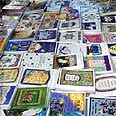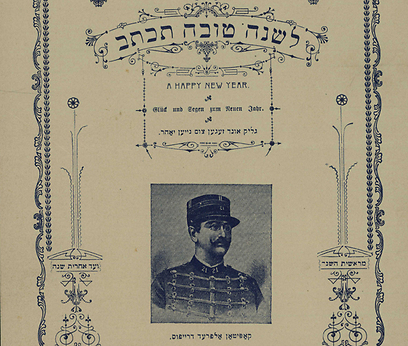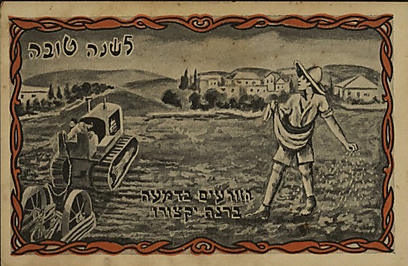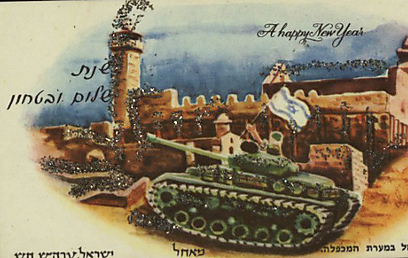
Shana Tova from Alfred Dreyfus
For some 100 years, Rosh Hashana greeting cards constituted main body of postcards sent by Jews. Before State's inception they featured Zionist values, when IDF was established – figure of Israeli soldier became central feature
The earliest instance of a written "Shana Tova" greeting is a 14th century letter written by the Ashkenazi rabbi known as the Maharil (Jacob ben Moses Moelin). This letter affirms the existence of the custom in German Jewish communities at that time.
In the 18th century, the custom began spreading beyond the German-speaking realm to other large concentrations of Jews in Eastern Europe, especially Poland. By the end of the century, cards sent in the time leading up to Rosh Hashana began to take on distinct characteristics, such as special writing paper, and the custom continued to spread throughout the Ashkenazi world during the 19th century.
Golden age of postcards
Around the time that the postal service emerged, in the 1880s, Jewish entrepreneurs were beginning to print commercial greeting cards for the New Year. By this time, New Year greetings constituted the main body of postcards sent by Jews, and this would remain so for some 100 years.
During the two decades between the end of the 19th century and the end of WWI (1898-1918), a time known as the "Golden Age of Postcards", the vast majority of the mail sent by Jews in Europe and America consisted of New Year cards.

Herzl and the Ottoman sultan (photo courtesy of the National Library)

Shana Tova with a portrait of Captain Dreyfus (photo courtesy of the National Library)

Letter from an Yiddish newspaper in Bergen Belsen, 1946 (photo courtesy of the National Library)
The cards usually featured Jewish motifs: Traditional and ideological symbols or illustrations depicting events of note in Jewish history.
With the advent of the Zionist movement, New Year cards became a platform for conveying ideological messages and Zionist perspectives on current events. For example, there were New Year cards featuring portraits of Herzl and Nordau, one featuring Herzl and the Ottoman sultan, and even those addressing current events such as the Dreyfus affair.
The cards played an important role in fundraising for community purposes. This custom originated in traditional institutions such as the early settlement in the Palestine.
Calendars, too, were printed for fundraising purposes as the New Year approached. Secular nationalist organizations – such as the Jewish National Fund, Keren Hayesod and the Joint Distribution Committee – followed suit.
History in postcards
New Year cards from the renewed settlement, and the years after the establishment of the State, also feature central Zionist values, such as agricultural labor, a return to Biblical paradigms, the local landscape, cultural and economic undertakings, milestones in reclaiming the land and founding of state institutions, the immigration struggle, the Haganah ("The Defense"), the settlement movement, and so forth.

The Messiah is arriving (photo courtesy of the National Library)

Military encampment, 1947, caption from the Bible (photo courtesy of the National Library)

'Those who sow with tears will reap with songs of joy' (photo courtesy of the National Library)
When the IDF was established, during the War of Independence, the figure of the Israeli soldier became the central feature of that generation's Israeli New Year cards, especially between the Six-day War and the Yom Kippur War.
Soldiers on parade, soldiers against the background of a unified Jerusalem, soldiers moving into the old city, soldiers marching, paratroopers beside the Western Wall, male and female soldiers against a local landscape, air force displays, tanks and even a scene depicting the breaching of the Old City, all adorn the cards of the period.

Soldiers celebrating at the Western Wall (photo courtesy of the National Library)

'Our forces at the Cave of the Patriarchs' (photo courtesy of the National Library)

Israeli family (photo courtesy of the National Library)
To the contemporary observer, these greeting cards recall a time of ideological unity and naïve and uninhibited national pride. The young country was establishing itself, growing stronger, and demonstrating pride in its accomplishments. At the same time, those were humbler, simpler times in terms of materials conveniences.
The vast majority of Israelis did not have telephones in their homes, and the mail was the standard means of communicating. Even short geographic distances, for example from Hadera to Netanya or from Haifa to Nahariya, were perceived as large enough to warrant and even impel communication via mail.
As Rosh Hashana approached, the volume of mail would peak, with enormous quantities of cards added to the regular letters. Postmen carried enormous leather bags bulging with envelopes and decorative postcards.
With the advent of mass communications, beginning with the telephone in the 1970s, the New Year card began to decline in popularity both in the Jewish world and in Israel.
Today, in the age of cellular telephones, email and social networks, New Year cards have almost entirely disappeared. However, there has been a recent revival of the custom out of nostalgia for a time when greetings were more personal and intimate.
- The writer is the Israel Collection curator at the National Library of Israel. A virtual exhibition of Rosh Hashana greeting cards can be found on the Library's website.










